Topics
Category
Era
Métis in Minnesota
In the Minnesota region during the eighteenth to mid-nineteenth centuries, métis, or mixed-ancestry, people often acted as bridges between white and Native American communities. The Métis cultural community of Pembina formed out of fur trade dynamics and influenced Minnesota during its territorial birth.
The term “métis” [\mā-tē(s)\] has more than one meaning. One references a person with mixed ancestry (métis means “mixed” in French) and is usually written with a lowercase “m”. For example, in Minnesota before statehood, having one Dakota parent and one Scottish parent made one métis. Government officials kept special census records, like the “Sioux Métis rolls,” of mixed-ancestry persons.
Another meaning of the term identifies present-day members of the Métis Nation of Canada. This specific mixed-ancestry group practices distinct ways of life. People representative of both groups—the métis and the Métis Nation—were involved in the fur trade era in pre-territorial Minnesota and around the Great Lakes.
Mothers of Métis and mixed-ancestry children of the Great Lakes region came from the Dakota and Ojibwe nations as well as the Menominee, Potawatomi, Meskwaki, Sauk, Ho Chunk, Odawa, Cree, and Assiniboine. Scottish, Irish, French, and British fathers lived during the French, British, and American periods of colonization. They were coureurs de bois (French or métis traders), voyageurs, artisans, merchants, soldiers, officers, and government workers. Additionally, some mixed ancestry children had one Black parent and one Native parent.
Historical accounts describe marriages of men with African ancestry with Native women. James Thompson (eventually freed from slavery) married a Dakota woman in 1833. Joseph Godfrey escaped slavery and married a Dakota woman named Takanyeca in 1857. Pierre Bonga, a free man, married an Ojibwe woman, and their son George Bonga married Ashwewin, who was Ojibwe as well. These men lived and died in close association with their wives’ communities.
Marriages with Native women allowed the men to build bonds with their wives’ extended families. These husbands tapped into new economic opportunities, accessed hunting areas, influenced trading, and benefited from the many skills and kinship ties of their Native wives. The women themselves also gained social status, influence, and access to resources. Some of these marriages were á la façon du pays, French for “according to the custom of the country.” In some cases, the European and American colonial powers legally recognized marriages as well as divorces. Some fathers were committed to raising their mixed-ancestry children; others abandoned them.
Historically, métis lived with complicated identities. In pre-territorial and territorial Minnesota, mixed-ancestry people acted as translators, guides, teachers, farmers, traders, missionaries, and entrepreneurs. The métis were able to use different parts of their identity in order to survive day to day. This made for a variety of life stories.
Jane Lamont, the Scottish and Dakota granddaughter of the Dakota leader Mahpiya Wicasta (Cloud Man), lost both her parents before she was nineteen years old. She was at first a teacher, then chose homesteading and marriage to the nephew of the missionary Samuel Pond. On the other hand, Mary Taliaferro Woodbury, another métis woman, lived with her children in St. Paul. She lost her husband, a soldier, in 1863, then moved her family to a reservation in 1887 or 1888 to live with her Dakota relatives.
In the 1820s, the number of mixed-ancestry families and children in Minnesota soared. This began to change in the mid-to-late 1800s, when the need for the métis as go-betweens declined. At this time, métis faced increasingly negative reactions from society for being persons of mixed ancestry. Social options for the métis became more limited. Some mixed-ancestry people tried to join mainstream, Euro-American ways of life (at least outwardly). Others moved with Native relatives to reservations.
Native nations often looked after their mixed-ancestry relatives. Pelagie Faribault, a woman of mixed Dakota ancestry, received land through an 1820 treaty with the Dakota. Roughly between 1830 and 1851, the Lake Pepin region contained land set aside by treaty for mixed-ancestry families. Much of it was lost to white colonists or exchanged for land certificates (scrip) in other locations. A draft of a U.S. treaty with the Pembina and Red Lake Ojibwe—written in 1851 but never ratified—included a sum of money for mixed-ancestry relatives.
Various mixed-ancestry families usually lived near fur-trading sites from the late 1700s into the 1800s. Many raised children next to each other. Some lived near Fort Snelling and in Mendota, Prairie du Chien, and, later, Lake Pepin (on the Mississippi River). Many of them knew the Red River and Pembina Métis and often interacted with them.
International and state borders shifted during the nineteenth century so that the Pembina Métis community was sometimes in Canada and at other times in Minnesota, Dakota, and Iowa Territories. Minnesota played a geographically important role to the culturally distinct Métis in Canada. The distinct Plains Red River Métis, or “La Nation,” routinely traveled on oxcart routes starting in the 1820s. These routes went through what is now Prairie du Chien in Wisconsin, Fort Snelling in St Paul, Pembina in North Dakota, and the Red River Colony in Manitoba, Canada.
These Métis traded and conducted business of various kinds. Minnesota Territory, before statehood, actually included Pembina. Pembina also had a Minnesota Territorial representative, Joseph Rolette, who had married into a culturally Métis family.
Brigades of Métis hunters with ox-drawn wooden carts went after buffalo until the mid-nineteenth century. The hunting of buffalo sometimes caused conflict with nearby Native American nations. A form of seasonal food gathering continues to the present day in Métis communities.
Louis Riel, the famous leader of the Canadian Red River Métis, visited a relative in Minnesota in 1878 and, for a short time, lived in Saint Paul. He approached John Ireland, the city’s Roman Catholic Bishop, and asked for help in resettling “Canadiens” to the United States. Some were probably Métis.
Ireland did not help Riel. In 1885, the Canadian government ordered his death for his role in organizing Métis armed resistance. The French Canadian town of Gentilly, Minnesota, mourned the execution as a symbol of the oppression of French speakers.
In the Red River Valley and Pembina, Métis intermarried and passed on a culture combining what their parents had brought from their own backgrounds. Certain symbols persist in the present day as markers of Métis life. Brightly colored sashes and the sash dance, floral beadwork, and the infinity symbol flag are symbols of Métis culture. Métis music and dance traditions include jigging, fiddling, and tunes such as the Duck Dance Fiddle Song. Some Métis families celebrate Easter and maple sugar season with specific foods, like crepes with maple syrup. Linguists recognize the French Métis language and Michif as official languages spoken in the United States and Canada.
As of 2017, Canada and the United States maintain different Métis policies. Canada formally recognizes some Métis groups as having legal rights. The United States does not view métis peoples as a distinct group. Nonetheless, métis people in several states have formed organizations based on cultural heritage and métis rights.
Bibliography
Babcock, Willoughby M. “With Ramsey to Pembina: A Treaty Making Trip in 1851.” Minnesota History 38, no. 1 (March 1962): 1–10.
http://collections.mnhs.org/MNHistoryMagazine/articles/38/v38i01p001-010.pdf
Bachman, Walt. Northern Slave, Black Dakota: The Life and Times of Joseph Godfrey. Bloomington, MN: Pond Dakota Press, 2013.
Basson, Lauren, L. White Enough to Be American? Race Mixing, Indigenous People, and the Boundaries of State and Nation. Chapel Hill, NC: The University of North Carolina Press, 2008.
Benoit, Virgil. “Gentilly: A French-Canadian Community in the Minnesota Red River Valley.” Minnesota History 44, no. 8 (Winter 1975): 278–289.
http://collections.mnhs.org/MNHistoryMagazine/articles/44/v44i08p278-289.pdf
Campbell, Maria. “Forward: Charting the Way.” In Contours of a People: Metis Family, Mobility, and History, edited by Nicole St-Onge, Carolyn Podruchny, and Brenda Macdougall, xiii-xxvi. Norman, OK: University of Oklahoma Press, 2012.
Carroll, Jane Lamm. “’Who Was Jane Lamont?’ Anglo-Dakota Daughters in Early Minnesota.” Minnesota History 59, no. 5 (Spring 2005): 184–196.
http://collections.mnhs.org/mnhistorymagazine/articles/59/v59i05p184-196.pdf
Denial, Catherine, J. Making Marriage: Husbands, Wives and the American State in Dakota and Ojibwe Country. St. Paul: Minnesota Historical Society Press, 2013.
Flanagan, Thomas. “Louis Riel and the Dispersion of the American Metis.” Minnesota History 49, no. 5 (Spring 1985): 179–190.
http://collections.mnhs.org/MNHistoryMagazine/articles/49/v49i05p179-190.pdf
Andrew Godfrey family book, 1801-1917
Manuscript Collection, Little Canada Historical Society, Little Canada
Description: Genealogical records of the Godfrey family associated with the founding of Little Canada.
Kugel, Rebecca. “Reworking Ethnicity: Gender, Work Roles, and Contending Redefinitions of the Great Lakes Métis, 1820–1842.” In Enduring Nations: Native Americans in the Midwest, edited by R. David Edmunds, 160–181. Urbana and Chicago: University of Illinois Press, 2008.
Merriam Webster Dictionary.
https://www.merriam-webster.com/dictionary/m%C3%A9tis
Murphy, Lucy Eldersveld. A Gathering of Rivers: Indians, Métis, and Mining in the Western Great Lakes, 1737–1832. Lincoln, NE: University of Nebraska Press, 2000.
Peterson, Jacqueline. “Many Roads to Red River: Métis Genesis in the Great Lakes region, 1680–1815.” In The New Peoples: Being and Becoming Métis in North America, edited by Jacqueline Peterson and Jennifer S. Brown, 37–71. St. Paul: Minnesota Historical Society, 2001.
Pritchett, John Perry. “Some Red River Fur-Trade Activities.” Minnesota History 5, no. 6 (May 1924): 401–423. http://collections.mnhs.org/MNHistoryMagazine/articles/5/v05i06p401-423.pdf
Sperry, Elizabeth. “Ethnogenesis of Metis, Cree, and Chippewa in Twentieth Century Montana.” Master’s Thesis, University of Montana, 2007.
http://scholarworks.umt.edu/etd/385/
St.-Onge, Nicole “Familial Foes? French-Sioux families and Plains Métis Brigades in the Nineteenth Century.” American Indian Quarterly 39 (Summer 2015): 302–337.
Teillet, Jean. “Boundaries of the Metis Nation” Presentation slides, December 2011. http://www.metisportals.ca/cons/wp-content/uploads/2011/12/Boundaries-of-the-Metis-Nation-2011.pdf
Wingerd, Mary Lethert. North Country: The Making of Minnesota. Minneapolis: University of Minnesota Press, 2010.
Related Resources
Primary
Alan R. Woolworth papers, 1774–2008 (bulk 1830–2000)
Manuscript Collection, Minnesota Historical Society, St. Paul
Description: A portion of this collection brings together life sketches of individuals who are part of the Minnesota historical record, including mixed-ancestry persons such as Mary Alice Bird, Helen Hastings Sibley, William Whipple Warren, and members of the Renville, LaFramboise, and Rolette families.
http://www2.mnhs.org/library/findaids/00339.xml
Alexis Bailly papers, 1821–1898
Manuscript Collection, Minnesota Historical Society, St. Paul
Description: Letters and papers related to the fur trade and the Minnesota Territorial Legislature.
http://www.mnhs.org/library/findaids/01136.xml
BA10/.A512b
American Board of Commissioners for Foreign Missions correspondence, 1827–1878
Manuscript Collection, Minnesota Historical Society, St. Paul
Description: Documents, including a school enrollment record with names of mixed-ancestry students
P2264
George A. Belcourt Papers, 1832–1857, 1927
Manuscript Collection, Minnesota Historical Society, St. Paul
Description: Includes documents about Native Americans at Pembina and also materials on the Red River area.
Joel Bean Bassett papers, 1859–1876 (bulk 1865–1868)
Manuscript Collection, Minnesota Historical Society, St. Paul
Description: This collection contains letters from George Bonga.
http://www.mnhs.org/library/findaids/p2243.xml
Northwest Missions Manuscripts and Index, 1776–1926
Manuscript Collection, Minnesota Historical Society, St. Paul
Description: Some material on Lac qui Parle and the Red River area.
http://www2.mnhs.org/library/findaids/00784.xml
Secondary
Anderson, Chris. “Métis”: Race, Recognition, and the Struggle for Indigenous Peoplehood. Vancouver, CA: UBC Press, 2014.
Anderson, Gary Clayton. Kinsmen of Another Kind: Dakota-White Relations in the Upper Mississippi Valley, 1650–1862. St. Paul: Minnesota Historical Society Press, 1997.
Barkwell, Lawrence ed. “Governor Ramsey’s 1851 Treaty with the Chippewa and Half Breeds." Louis Riel Institute.
https://www.scribd.com/document/133103178/Treaty-Ramsey-1851-Metis-Treaty
Brown, Jennifer S. H. Strangers in Blood: Fur Trade Company Families in Indian Country. Norman: University of Oklahoma Press, 1996.
Carroll, Jane Lamm. “‘This Higgledy-Piggledy Assembly’: The McLeods, an Anglo-Dakota Family in Early Minnesota.” Minnesota History 60, no. 6 (Summer 2007): 218–233.
http://collections.mnhs.org/MNHistoryMagazine/articles/60/v60i06p218-233.pdf
——— . “Naginowenah, Lucy Prescott, and the Wizard of Cereal Foods: Cultural Identity across Three Generations of an Anglo-Dakota Family.” Minnesota History 63, no. 2 (Summer 2012): 56–68.
http://collections.mnhs.org/mnhistorymagazine/articles/63/v63i02p058-068.pdf
Dueck, Byron. “Public and Intimate Sociability in First Nations and Métis Fiddling.” Ethnomusicology 51, no. 1 (Winter 2007): 30–63.
Ehrenhalt, Lizzie. “‘The Most Satisfactory Proof’: Revising an Anglo-Dakota Family History.” Minnesota History 63, no. 4 (Winter 2012/2013): 144–155.
http://collections.mnhs.org/MNHistoryMagazine/articles/63/v63i04p144-155.pdf
Foxcurran, Robert, Michel Bouchard, and Sébastian Malette. Songs Upon the Rivers: The Buried History of the French-Speaking Canadiens and Métis from the Great Lakes and the Mississippi Across to the Pacific. Montréal: Baraka Books, 2016.
Gilman, Carolyn. “A Day in the Life of the Gens Libres.” Minnesota History 56, no. 4 (Winter 1998–1999): 175–177.
http://collections.mnhs.org/MNHistoryMagazine/articles/56/v56i04p175-177.pdf
Gilman, Rhoda. The Red River Trails: Oxcart Routes from between St. Paul and the Selkirk Settlement, 1820–1870. St. Paul: Minnesota Historical Society Press, 1979.
Harrison, Julia D. Metis: People between Two Worlds. Vancouver, CA: Glenbow-Alberta Institute in association with Douglas & McIntyre, 1985.
Heilbron, Bertha L. “Artist as Buffalo Hunter: Paul Kane and the Red River Half Breeds.” Minnesota History 36, no. 8 (December 1959) 309–314.
http://collections.mnhs.org/MNHistoryMagazine/articles/36/v36i08p309-314.pdf
Hogue, Michel. Metis and the Medicine Line: Creating a Border and Dividing a People. Chapel Hill, NC: University of North Carolina Press, 2015.
Jackson, John C. Children of the Fur Trade: Forgotten Metis of the Pacific Northwest. Corvallis, OR: Oregon State University Press, 2007.
Klein, Alex. “The Voice of Progress: A Conflicted Message of Resistance in the White Earth Reservation’s First Newspaper.” Minnesota History 65, no. 5 (Spring 2017): 188–200.
http://collections.mnhs.org/MNHistoryMagazine/articles/65/v65i05p188-200.pdf
Kohn, Bruce A. Dakota Child, Governor’s Daughter: The Life of Helen Hastings Sibley. Mendota, MN: Friends of the Sibley Historic Site, 2012.
Morton, Arthur S. “The Nation, The Métis.” Proceedings and Transactions of the Royal Society of Canada 33, no. 3, section 2 (1939): 137–145.
Nute, Grace Lee ed. “The Diary of Martin McLeod.” Minnesota History 4, no. 7–8 (August–November 1922): 351–439. http://collections.mnhs.org/MNHistoryMagazine/articles/4/v04i7-8p351-439.pdf
——— . “Posts in the Minnesota Fur-Trading Area, 1660–1855.” Minnesota History 11, no. 4 (December 1930): 353–385.
http://collections.mnhs.org/MNHistoryMagazine/articles/11/v11i04p353-385.pdf
Pearson, Marjorie, and Penny A. Peterson. Rapids, Reins, Rails: Transportation on the Minneapolis Riverfront. Hess, Roise and Company, May, 2009.
http://www.mnhs.org/places/safhb/pdf/earlytransportation_report.pdf
Podruchny, Carolyn. Making the Voyageur World: Travelers and Traders in the North American Fur Trade. Lincoln, NE: University of Nebraska Press, 2006.
Rogers, Virginia. “The Indians and the Métis: Genealogical Sources on Minnesota’s Earliest Settlers.” Minnesota History 46, no. 7 (Fall 1979): 286–296.
http://collections.mnhs.org/MNHistoryMagazine/articles/46/v46i07p286-296.pdf
Van Kirk, Sylvia. Many Tender Ties: Women in Fur-Trade Society, 1670–1870. Norman, OK: University of Oklahoma Press, 1980.
White, Bruce M. “The Power of Whiteness, Or, the Life and Times of Joseph Rollette Jr.” Minnesota History 56, no. 4 (Winter 1998–1999): 178–197.
http://collections.mnhs.org/MNHistoryMagazine/articles/56/v56i04p178-197.pdf
White, Richard. The Middle Ground: Indians, Empires, and Republics in the Great Lakes Region, 1650–1815. New York: Cambridge University Press, 1991.
Woolworth, Alan R. “The Lives and Influences of the Andrew Robertson Family: Members of the Santee Dakota Indian Metis Community.” Minnesota's Heritage no. 1 (January 2010): 114–120.
Web
"Language of the Fur Trade Mnhs." Minnesota Historical Society via Scirbd user Jeff Pavlik.
https://www.scribd.com/document/57212070/Language-of-the-Fur-Trade-Mnhs
“History of the Metis Jig.” YouTube video, 5:15. Posted by “Edmonton Regional Learning Consortium – ERLC,” January 12, 2017.
Originally found at: https://www.youtube.com/watch?v=WHe9POEmJyw
Related Images
A pair of beaded Dakota-Metis half leggings, probably from the Red River region of North Dakota, Minnesota, and Manitoba, made in the mid 1800s. The leggings are beaded on their front faces with a series of standalone fantasy floral and double-curved motifs typical of Dakota-Metis (as well as Santee Dakota and some Crow) beadwork decoration. Each legging is bordered in a beaded checkerboard motif.
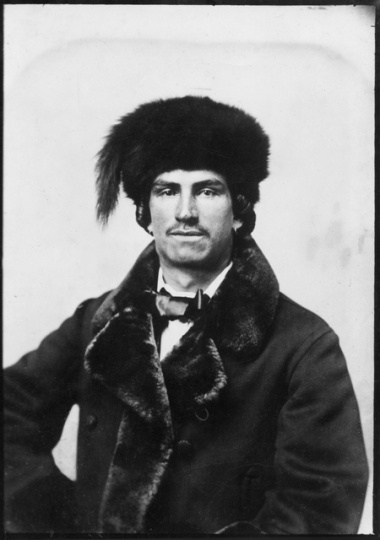
Métis fur trader
An unidentified Métis fur trader of Native American and French ancestry, ca. 1870.
Public domain
Holding Location
Articles
More Information
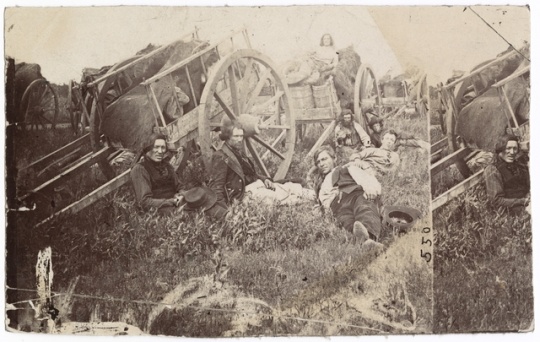
Métis drivers with Red River ox carts
Métis drivers with Red River ox carts, probably in Minnesota, 1860. Photograph by Benjamin Franklin Upton.
Public domain
Holding Location
More Information
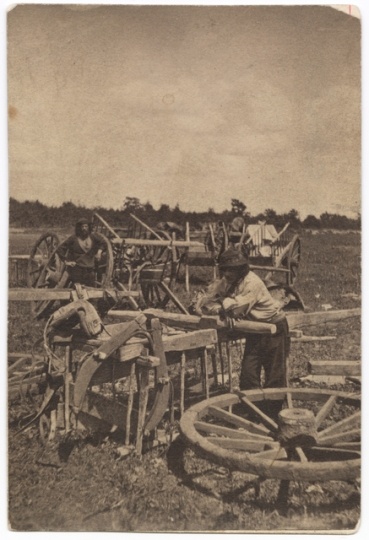
Preparing a Red River cart train at Pembina for a trip to St. Anthony Falls
Two men, probably Métis, preparing a Red River cart train at Pembina, 1856.
Public domain
Holding Location
Articles
More Information
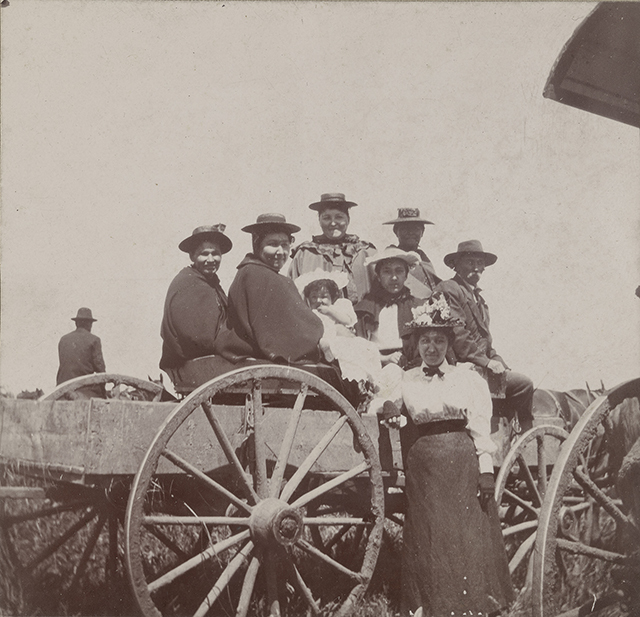
The Blu family
An eight-person mixed-race Ojibwe family, including a baby, on the White Earth Reservation, ca. 1897. Cropped from the original.
Public domain
Holding Location
Articles
More Information
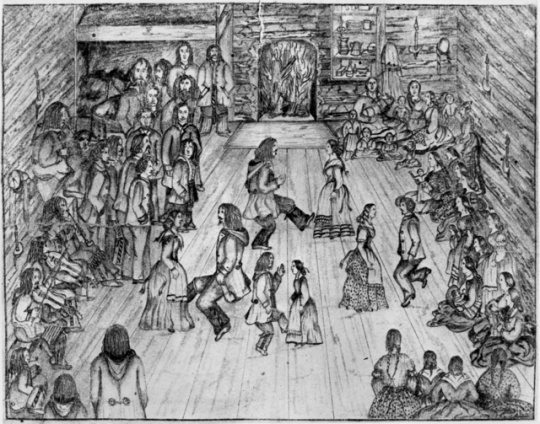
Métis dance, Devil’s Lake, Dakota Territory
Métis dance at Devil’s Lake, Dakota Territory, ca. 1870. Drawing by Corporal Louis Voelkerer, Company A, Thirty-first United States Infantry.
Public domain
Holding Location
Articles
More Information
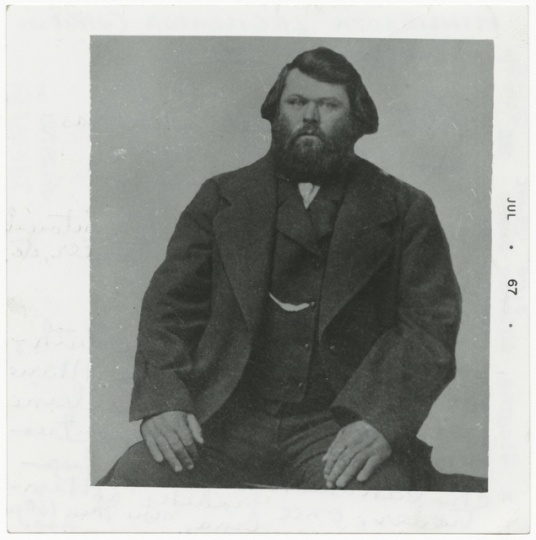
Antoine Blanc Gingras
Antoine Blanc Gingras, Métis fur trader and member of the Minnesota Territorial Legislature, ca. 1855.
Public domain
Holding Location
Articles
More Information
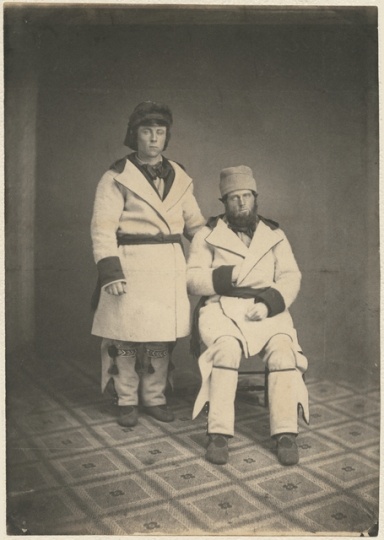
Dog team drivers
Dog team drivers (Tarbell and Campbell) from Pembina, 1856.
Public domain
Holding Location
Articles
More Information
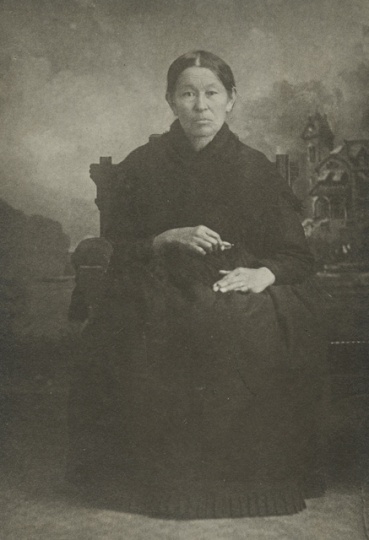
Angélique Jerome Rolette, wife of Joseph Rolette
Angélique Jerome Rolette, wife of Joseph Rolette, c.1880.
Public domain
Holding Location
More Information
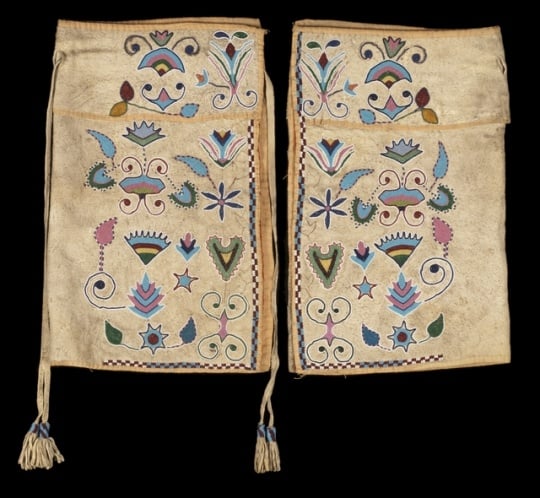
Half leggings
A pair of beaded Dakota-Metis half leggings, probably from the Red River region of North Dakota, Minnesota, and Manitoba, made in the mid 1800s. The leggings are beaded on their front faces with a series of standalone fantasy floral and double-curved motifs typical of Dakota-Metis (as well as Santee Dakota and some Crow) beadwork decoration. Each legging is bordered in a beaded checkerboard motif.
All rights reserved
Holding Location
More Information
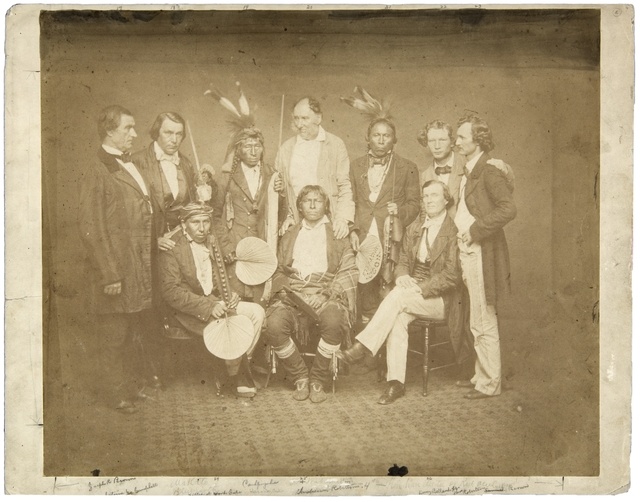
1858 treaty delegation
Members of the Dakota treaty delegation in Washington, 1858. Included in the delegation are members of the Métis community: Antoine (Joseph) Campbell (standing second from left), Thomas A Robertson (standing second from left), and Nathaniel Brown (standing at right).
Public domain
Holding Location
Articles
More Information
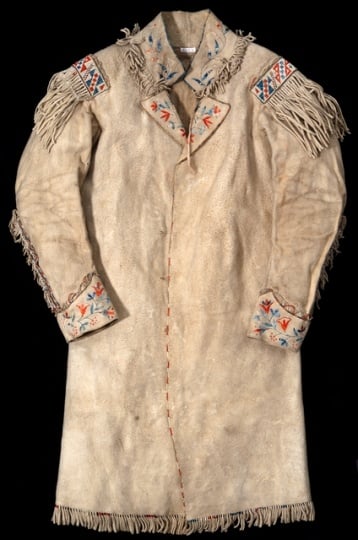
Quilled coat
This style of coat was popular with the Métis of the Red River Valley. This particular coat belonged to Alexander Ramsey and may have been brought back by him from an 1851 treaty signing. The coat is possibly Cree, Métis, or Ojibwe in origin.
All rights reserved
Holding Location
Articles
More Information
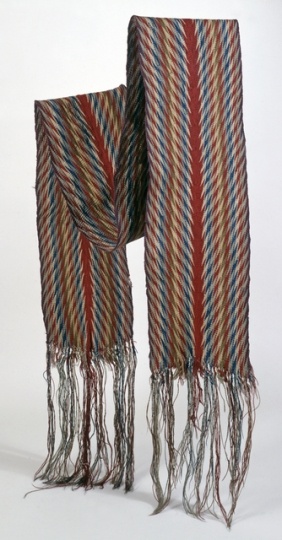
Finger-woven sash
French-Canadian finger-woven wool sash in ceinture flechee or “arrow sash" pattern, ca. 1750–1800. This type of sash is associated with the Pembina, North Dakota, and L'Assomption, Quebec, area and is possibly Métis.
All rights reserved
Holding Location
Articles
More Information
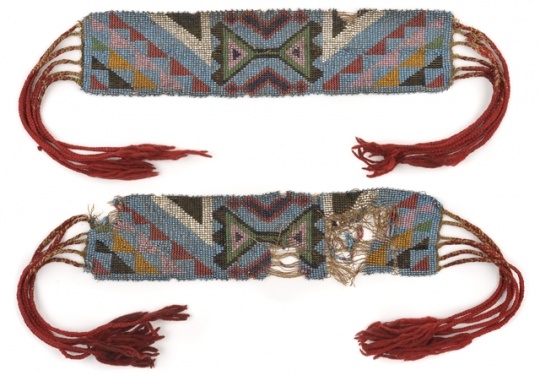
Loom-woven bead work and yarn garters
Loom woven garters that originated in the area around Selkirk, Manitoba, and are possibly Ojibwe, Métis, or Cree, ca. 1820s.
All rights reserved
Holding Location
Articles
More Information
Related Articles
Turning Point
In 1849, the U.S. government establishes the Minnesota Territory, which annexes the lands and communities of the Pembina Métis and some other Métis groups.
Chronology
1603
1670
1720s
1767
1784
1798/1799
1780s to 1790s
1820
1820s
1822
1849
1849
1854
1878
1885
Bibliography
Babcock, Willoughby M. “With Ramsey to Pembina: A Treaty Making Trip in 1851.” Minnesota History 38, no. 1 (March 1962): 1–10.
http://collections.mnhs.org/MNHistoryMagazine/articles/38/v38i01p001-010.pdf
Bachman, Walt. Northern Slave, Black Dakota: The Life and Times of Joseph Godfrey. Bloomington, MN: Pond Dakota Press, 2013.
Basson, Lauren, L. White Enough to Be American? Race Mixing, Indigenous People, and the Boundaries of State and Nation. Chapel Hill, NC: The University of North Carolina Press, 2008.
Benoit, Virgil. “Gentilly: A French-Canadian Community in the Minnesota Red River Valley.” Minnesota History 44, no. 8 (Winter 1975): 278–289.
http://collections.mnhs.org/MNHistoryMagazine/articles/44/v44i08p278-289.pdf
Campbell, Maria. “Forward: Charting the Way.” In Contours of a People: Metis Family, Mobility, and History, edited by Nicole St-Onge, Carolyn Podruchny, and Brenda Macdougall, xiii-xxvi. Norman, OK: University of Oklahoma Press, 2012.
Carroll, Jane Lamm. “’Who Was Jane Lamont?’ Anglo-Dakota Daughters in Early Minnesota.” Minnesota History 59, no. 5 (Spring 2005): 184–196.
http://collections.mnhs.org/mnhistorymagazine/articles/59/v59i05p184-196.pdf
Denial, Catherine, J. Making Marriage: Husbands, Wives and the American State in Dakota and Ojibwe Country. St. Paul: Minnesota Historical Society Press, 2013.
Flanagan, Thomas. “Louis Riel and the Dispersion of the American Metis.” Minnesota History 49, no. 5 (Spring 1985): 179–190.
http://collections.mnhs.org/MNHistoryMagazine/articles/49/v49i05p179-190.pdf
Andrew Godfrey family book, 1801-1917
Manuscript Collection, Little Canada Historical Society, Little Canada
Description: Genealogical records of the Godfrey family associated with the founding of Little Canada.
Kugel, Rebecca. “Reworking Ethnicity: Gender, Work Roles, and Contending Redefinitions of the Great Lakes Métis, 1820–1842.” In Enduring Nations: Native Americans in the Midwest, edited by R. David Edmunds, 160–181. Urbana and Chicago: University of Illinois Press, 2008.
Merriam Webster Dictionary.
https://www.merriam-webster.com/dictionary/m%C3%A9tis
Murphy, Lucy Eldersveld. A Gathering of Rivers: Indians, Métis, and Mining in the Western Great Lakes, 1737–1832. Lincoln, NE: University of Nebraska Press, 2000.
Peterson, Jacqueline. “Many Roads to Red River: Métis Genesis in the Great Lakes region, 1680–1815.” In The New Peoples: Being and Becoming Métis in North America, edited by Jacqueline Peterson and Jennifer S. Brown, 37–71. St. Paul: Minnesota Historical Society, 2001.
Pritchett, John Perry. “Some Red River Fur-Trade Activities.” Minnesota History 5, no. 6 (May 1924): 401–423. http://collections.mnhs.org/MNHistoryMagazine/articles/5/v05i06p401-423.pdf
Sperry, Elizabeth. “Ethnogenesis of Metis, Cree, and Chippewa in Twentieth Century Montana.” Master’s Thesis, University of Montana, 2007.
http://scholarworks.umt.edu/etd/385/
St.-Onge, Nicole “Familial Foes? French-Sioux families and Plains Métis Brigades in the Nineteenth Century.” American Indian Quarterly 39 (Summer 2015): 302–337.
Teillet, Jean. “Boundaries of the Metis Nation” Presentation slides, December 2011. http://www.metisportals.ca/cons/wp-content/uploads/2011/12/Boundaries-of-the-Metis-Nation-2011.pdf
Wingerd, Mary Lethert. North Country: The Making of Minnesota. Minneapolis: University of Minnesota Press, 2010.
Related Resources
Primary
Alan R. Woolworth papers, 1774–2008 (bulk 1830–2000)
Manuscript Collection, Minnesota Historical Society, St. Paul
Description: A portion of this collection brings together life sketches of individuals who are part of the Minnesota historical record, including mixed-ancestry persons such as Mary Alice Bird, Helen Hastings Sibley, William Whipple Warren, and members of the Renville, LaFramboise, and Rolette families.
http://www2.mnhs.org/library/findaids/00339.xml
Alexis Bailly papers, 1821–1898
Manuscript Collection, Minnesota Historical Society, St. Paul
Description: Letters and papers related to the fur trade and the Minnesota Territorial Legislature.
http://www.mnhs.org/library/findaids/01136.xml
BA10/.A512b
American Board of Commissioners for Foreign Missions correspondence, 1827–1878
Manuscript Collection, Minnesota Historical Society, St. Paul
Description: Documents, including a school enrollment record with names of mixed-ancestry students
P2264
George A. Belcourt Papers, 1832–1857, 1927
Manuscript Collection, Minnesota Historical Society, St. Paul
Description: Includes documents about Native Americans at Pembina and also materials on the Red River area.
Joel Bean Bassett papers, 1859–1876 (bulk 1865–1868)
Manuscript Collection, Minnesota Historical Society, St. Paul
Description: This collection contains letters from George Bonga.
http://www.mnhs.org/library/findaids/p2243.xml
Northwest Missions Manuscripts and Index, 1776–1926
Manuscript Collection, Minnesota Historical Society, St. Paul
Description: Some material on Lac qui Parle and the Red River area.
http://www2.mnhs.org/library/findaids/00784.xml
Secondary
Anderson, Chris. “Métis”: Race, Recognition, and the Struggle for Indigenous Peoplehood. Vancouver, CA: UBC Press, 2014.
Anderson, Gary Clayton. Kinsmen of Another Kind: Dakota-White Relations in the Upper Mississippi Valley, 1650–1862. St. Paul: Minnesota Historical Society Press, 1997.
Barkwell, Lawrence ed. “Governor Ramsey’s 1851 Treaty with the Chippewa and Half Breeds." Louis Riel Institute.
https://www.scribd.com/document/133103178/Treaty-Ramsey-1851-Metis-Treaty
Brown, Jennifer S. H. Strangers in Blood: Fur Trade Company Families in Indian Country. Norman: University of Oklahoma Press, 1996.
Carroll, Jane Lamm. “‘This Higgledy-Piggledy Assembly’: The McLeods, an Anglo-Dakota Family in Early Minnesota.” Minnesota History 60, no. 6 (Summer 2007): 218–233.
http://collections.mnhs.org/MNHistoryMagazine/articles/60/v60i06p218-233.pdf
——— . “Naginowenah, Lucy Prescott, and the Wizard of Cereal Foods: Cultural Identity across Three Generations of an Anglo-Dakota Family.” Minnesota History 63, no. 2 (Summer 2012): 56–68.
http://collections.mnhs.org/mnhistorymagazine/articles/63/v63i02p058-068.pdf
Dueck, Byron. “Public and Intimate Sociability in First Nations and Métis Fiddling.” Ethnomusicology 51, no. 1 (Winter 2007): 30–63.
Ehrenhalt, Lizzie. “‘The Most Satisfactory Proof’: Revising an Anglo-Dakota Family History.” Minnesota History 63, no. 4 (Winter 2012/2013): 144–155.
http://collections.mnhs.org/MNHistoryMagazine/articles/63/v63i04p144-155.pdf
Foxcurran, Robert, Michel Bouchard, and Sébastian Malette. Songs Upon the Rivers: The Buried History of the French-Speaking Canadiens and Métis from the Great Lakes and the Mississippi Across to the Pacific. Montréal: Baraka Books, 2016.
Gilman, Carolyn. “A Day in the Life of the Gens Libres.” Minnesota History 56, no. 4 (Winter 1998–1999): 175–177.
http://collections.mnhs.org/MNHistoryMagazine/articles/56/v56i04p175-177.pdf
Gilman, Rhoda. The Red River Trails: Oxcart Routes from between St. Paul and the Selkirk Settlement, 1820–1870. St. Paul: Minnesota Historical Society Press, 1979.
Harrison, Julia D. Metis: People between Two Worlds. Vancouver, CA: Glenbow-Alberta Institute in association with Douglas & McIntyre, 1985.
Heilbron, Bertha L. “Artist as Buffalo Hunter: Paul Kane and the Red River Half Breeds.” Minnesota History 36, no. 8 (December 1959) 309–314.
http://collections.mnhs.org/MNHistoryMagazine/articles/36/v36i08p309-314.pdf
Hogue, Michel. Metis and the Medicine Line: Creating a Border and Dividing a People. Chapel Hill, NC: University of North Carolina Press, 2015.
Jackson, John C. Children of the Fur Trade: Forgotten Metis of the Pacific Northwest. Corvallis, OR: Oregon State University Press, 2007.
Klein, Alex. “The Voice of Progress: A Conflicted Message of Resistance in the White Earth Reservation’s First Newspaper.” Minnesota History 65, no. 5 (Spring 2017): 188–200.
http://collections.mnhs.org/MNHistoryMagazine/articles/65/v65i05p188-200.pdf
Kohn, Bruce A. Dakota Child, Governor’s Daughter: The Life of Helen Hastings Sibley. Mendota, MN: Friends of the Sibley Historic Site, 2012.
Morton, Arthur S. “The Nation, The Métis.” Proceedings and Transactions of the Royal Society of Canada 33, no. 3, section 2 (1939): 137–145.
Nute, Grace Lee ed. “The Diary of Martin McLeod.” Minnesota History 4, no. 7–8 (August–November 1922): 351–439. http://collections.mnhs.org/MNHistoryMagazine/articles/4/v04i7-8p351-439.pdf
——— . “Posts in the Minnesota Fur-Trading Area, 1660–1855.” Minnesota History 11, no. 4 (December 1930): 353–385.
http://collections.mnhs.org/MNHistoryMagazine/articles/11/v11i04p353-385.pdf
Pearson, Marjorie, and Penny A. Peterson. Rapids, Reins, Rails: Transportation on the Minneapolis Riverfront. Hess, Roise and Company, May, 2009.
http://www.mnhs.org/places/safhb/pdf/earlytransportation_report.pdf
Podruchny, Carolyn. Making the Voyageur World: Travelers and Traders in the North American Fur Trade. Lincoln, NE: University of Nebraska Press, 2006.
Rogers, Virginia. “The Indians and the Métis: Genealogical Sources on Minnesota’s Earliest Settlers.” Minnesota History 46, no. 7 (Fall 1979): 286–296.
http://collections.mnhs.org/MNHistoryMagazine/articles/46/v46i07p286-296.pdf
Van Kirk, Sylvia. Many Tender Ties: Women in Fur-Trade Society, 1670–1870. Norman, OK: University of Oklahoma Press, 1980.
White, Bruce M. “The Power of Whiteness, Or, the Life and Times of Joseph Rollette Jr.” Minnesota History 56, no. 4 (Winter 1998–1999): 178–197.
http://collections.mnhs.org/MNHistoryMagazine/articles/56/v56i04p178-197.pdf
White, Richard. The Middle Ground: Indians, Empires, and Republics in the Great Lakes Region, 1650–1815. New York: Cambridge University Press, 1991.
Woolworth, Alan R. “The Lives and Influences of the Andrew Robertson Family: Members of the Santee Dakota Indian Metis Community.” Minnesota's Heritage no. 1 (January 2010): 114–120.
Web
"Language of the Fur Trade Mnhs." Minnesota Historical Society via Scirbd user Jeff Pavlik.
https://www.scribd.com/document/57212070/Language-of-the-Fur-Trade-Mnhs
“History of the Metis Jig.” YouTube video, 5:15. Posted by “Edmonton Regional Learning Consortium – ERLC,” January 12, 2017.
Originally found at: https://www.youtube.com/watch?v=WHe9POEmJyw














